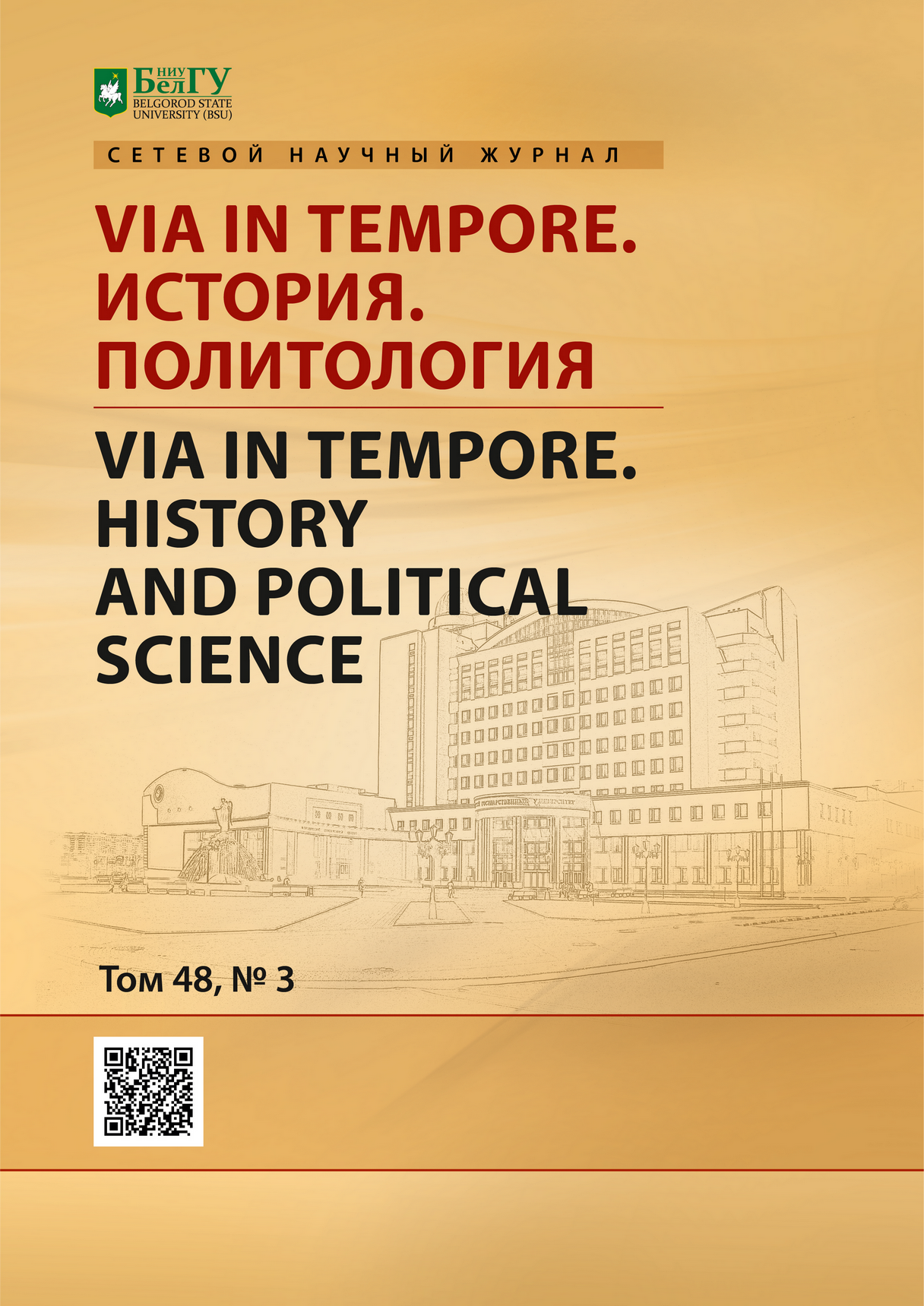The controversy over the date of q. Licinius Lucullus’ quaestorship and the inscription from Mopsuestia: the terminology for describing public offices
DOI:
https://doi.org/10.52575/2687-0967-2021-48-3-536-545Keywords:
Quaestor, proquaestor/pro quaestore, quaestor pro praetore, ταμίας, ταμίας καὶ ἀντιστράτηγος, L. Licinius Lucullus, Mopsuestia, discussion, datingAbstract
This paper charts the scholarly debates about the date of L. Licinius Lucullus’ quaestorship (and, therefore, his proquaestorship). The issue has been under discussion since the 1870s and is still far from being resolved given the discovery in the 1980s of a Greek inscription from Mopsuestia [1] which compels us to reconsider Lucullus’s official position in the 80s B. C. In the section which has been recognized by modern researchers as Lucullus’ official letter to the authorities and the people of Mopsuestia, Lucullus gives his title as ταμίας καὶ ἀντιστράτηγος, which corresponds to the Latin title quaestor pro praetore. The first editors of the inscription date the letter of Lucullus to 86 B. C, which contradicts the earlier scholarly suggestions to place Lucullus’ quaestorship in 88 or 87 B. C. In this connection, it is important to ask about the specificity of the epigraphical terminology for quaestors and proquaestors, especially in the cases where these officials were given power pro praetore. This paper reviews the wide variety of incompatible modern views on these issues and argues that the key to clarifying the specific situation of L. Licinius Lucullus and the date of his quaestorship is to study the evidence on all known cases of the activities of quaestors/proquaestors pro praetore. This will make it possible to examine Lucullus’s position within the general context of the Roman practice of granting praetorian powers to the lower magistrates and promagistrates.
Downloads
References
Дементьева В.В. 2013а. Греческие надписи о квестуре и проквестуре Л. Лициния Лукулла. Вестник Ярославского государственного университета им. П.Г. Демидова. Серия Гуманитарные науки. 4: 14–19.
Дементьева В.В. 2013б. Делосская латинская надпись о проквестуре Лукулла: Луций или Марк? Проблемы истории филологии и культуры. 4: 54–62.
Дементьева В.В. 2015. Надпись из Дельф (Supplementum Epigraphicum Graecum I. 153): квестор – Луций Лициний Лукулл? Иресиона. Античный мир и его наследие. Вып. IV. Сборник научных трудов к 50-летию профессора Н.Н. Болгова. Е.В. Литовченко, С.Н. Прокопенко, Е.А. Семичева (ред. кол.). Белгород, «Эпицентр», 119–125.
Дементьева В.В. 2019. Родосская надпись (Sylloge Inscriptionum Graecarum3, № 745): что связывало грека Поликла с римскими должностными лицами? Lumen intellectus. Памяти Ии Леонидовны Маяк. Сборник статей Научно-образовательного центра антиковедения ЯрГУ. Отв. ред. В.В. Дементьева. Ярославль, Филигрань, 53–67.
Ameling W. 1989. Licinius Lucullus in Chios. Zeitschrift für Papyrologie und Epigraphik. Bd. 77: 98–100.
Badian E. 1964. Studies in Greek and Roman History. Oxford, VIII + 290.
Broughton T.R.S. 1986a. The Magistrates of the Roman Republic. Vol. III. Atlanta, Georgia, IX + 294.
Broughton T.R.S. 1986b. The Magistrates of the Roman Republic. Vol. II. Atlanta, Georgia, IX+647.
Clerc M.A. Inscriptions de Thyatire et des environs. Bulletin de correspondance hellénique. 1886. Vol. 10: 398–423.
Choix d`inscriptions de Délos. 1923. Fasc. II. Avec traduction et commentaire par F. Dürrbach. Textes historiques. Paris, 294.
Corpus Inscriptionum Latinarum. 1918. Vol. I². Pars II. Fasc. I. Inscriptiones Latinae antiquissimae. Cura E. Lommatzsch. Berolini, 852.
Corpus Inscriptionum Latinarum. 1873. Vol. III. Pars I. Inscriptiones Asiae, provinciarum Europae Graecarum, Illyrici Latinae. Ed. Th. Mommsen. Berolini, 586.
Gelzer M. 1926. L. Licinius Lucullus. Real-Encyclopädie der classischen Altertumswissenschaft / A. Pauly, G. Wissowa (Hrsg.). Vol. XIII: 376–414.
Inscriptiones Latinae Selectae. 1892. Vol. 1. Ed. H. Dessau. Berlin, 580.
Keaveney A. 1992. Lucullus. A Life. London and New York, 296.
Kreiler B.M. Der Prokonsul Lentulus, der Imperator Murena und der Proquästor Lucullus. Tyche. Beiträge zur alten Geschichte, Papyrologie und Epigraphik. 2006. Bd. 21: 73–82.
Ooteghem, van J. 1959. Lucius Licinius Lucullus. Brussels, 236.
Pina Polo F., Díaz Fernández A. 2019. The Quaestorship in the Roman Republic. Berlin/Boston: Klio Beihefte, De Gruyter, 376.
Pomtow H. 1921. Delfische Neurfunde. Klio. Bd. 17: 163–164.
Ramsay W.M. 1883. Unedited Inscriptions of Asia Minor. Bulletin de correspondance hellénique. Vol. 7: 297–328.
Rigsby K.J. 1996. Asylia. Territoirial Inviolability in The Hellinic World. Berkeley, 835.
Sayar M.H., Siewert P., Taeuber H. 1994. Asylie-Erklärungen des Sulla und des Lucullus für das Isis- und Sarapisheiligtum von Mopsuhestia (Ostkilikien). Tyche. Beiträge zur Alten Geschichte, Papyrologie und Epigraphik. Bd. 9: 113–130.
Schütz G. 1994. L. Licinius Lucullus. Studien zu den frühen Jahren eines Nobilis (117–75 v. Chr.). Regensburg, 149 + XVI.
Sobeck F. 1909. Die Quästoren der Römischen Republik. Trebnitz, 95.
Supplementum Epigraphicum Graecum. 1994. Vol. XLIV. Amsterdam. 1997, XXXVIII +705.
Thonemann P.J. 2004. The Date of Lucullus’ Quaestorship. Zeitschrift für Papyrologie und Epigraphik. Bd. 149: 80–82.
Tröster M. 2008. Themes, Character and Politics in Plutarch’s Life of Lucullus. The Construction of a Roman Aristocrat. Stuttgart, 206.
Wosnik B. 1963. Untersuchungen zur Geschichte Sullas. Würzburg, 125.
Abstract views: 297
Share
Published
How to Cite
Issue
Section
Copyright (c) 2021 Via in tempore. History and political science

This work is licensed under a Creative Commons Attribution 4.0 International License.


